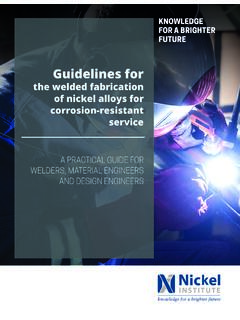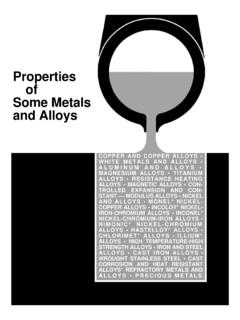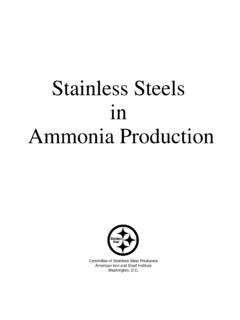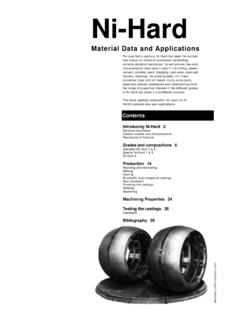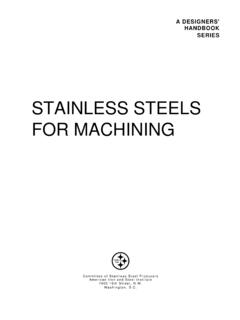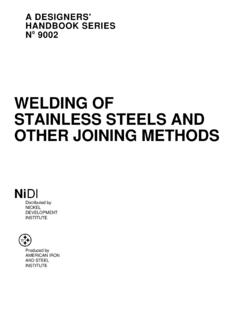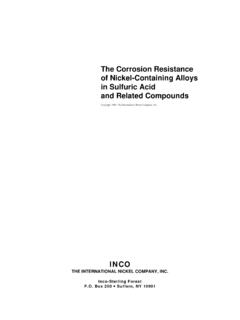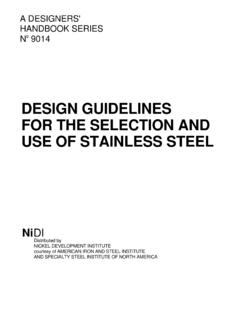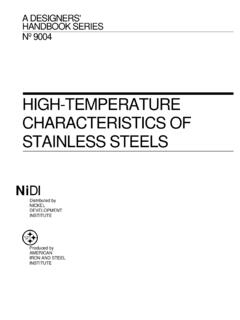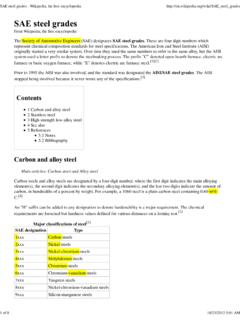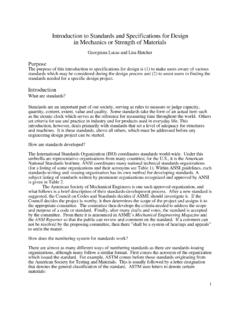Transcription of Properties and applications of ... - Nickel Institute
1 Properties and applications of electroless Nickel Nickel Development Institute Properties and applications of electroless Nickel Ron ParkinsonThe information contained in this publication has been compiled from the literature and through communication with recognized experts within the metal finishing industry. It is presented as a guide to the use of electroless Nickel for engineers, metallurgists, designers and others involved in materials selection. The important Properties of electroless Nickel deposits are described and examples given of how these Properties have been used successfully to solve materials problems in various industries.
2 Through presentation of this information, it is anticipated that new opportunities for the use of electroless Nickel coatings will become apparent to those not already familiar with their broad range of Properties , thereby promoting growth within the industry. 1 electroless Nickel plating is a process for depositing a Nickel alloy from aqueous solutions onto a substrate without the use of electric current. It differs, therefore, from electro-plating which depends on an external source of direct current to reduce Nickel ions in the electrolyte to Nickel metal on the substrate. electroless Nickel plating is a chemical process which reduces Nickel ions in solution to Nickel metal by chemical reduction.
3 The most common reducing agent used is sodium hypophosphite. Alternatives are sodium borohydride and dimethylamine borane but they are used much less frequently. It is estimated that sodium hypophosphite is used in more then 99% of all electroless Nickel plating1 and this publication refers only to the use of this reducing agent. It is not the intention of this publication to provide details of the electroless Nickel process but rather to review the Properties of the deposits and describe successful ap-plications. Some of the unique Properties of electroless Nickel , such as thickness uniformity, hardness, corrosion Properties and applications of electroless Nickel IntroductionNickel Development Institute3 resistance and magnetic response have resulted in its use in many different industries.
4 In spite of this, not all design-ers, engineers, metallurgists and others responsible for materials selection are aware of the value of electroless Nickel as an engineering or functional coating. However, it is firmly established as a functional coating in the electronics, oil and gas, chemical, aerospace and automotive industries, for instance. It is also recognized and used effectively in many others and the number of applications continues to grow. In the following pages, the engineering Properties of electroless Nickel are described and applications have been selected to demonstrate how these Properties have been used to resolve materials problems.
5 The information pre-sented should provide those involved in materials selection, with sufficient background to enable cost effective decisions to be made. Some of these decisions will favour electroless Nickel , thereby benefitting the industry and ensuring continued growth. Nickel Development Institute Properties of electroless Nickel Composition and Structure There are major differences between electrodeposited Nickel and electroless Nickel that are associated with their purity and structure. For instance, the purity of electrodeposited Nickel is typically greater than 99% but when sodium hypophosphite is used as a reducing agent in electroless Nickel plating, a typical composition for the deposit is 92% Nickel and 8% phosphorus.
6 The phosphorus content has a great effect on deposit Properties and it can be varied over a wide range, typically 3 to 12%. The industry normally identifies electroless Nickel coatings according to their phos-phorus content, Low phosphorus 2 - 5% P. Medium phosphorus 6 - 9% P. High Phosphorus 10 - 13% P. Consequently, once the performance requirements for the coating have been defined, it is essential that the appropriate type of electroless Nickel be specified. For instance, there are distinct differences in the corrosion resistance and hardness Properties of low and high phosphorus deposits, as described later. The structure of electroless Nickel is responsible for some of its unique Properties .
7 It differs greatly from the crystalline structure of electrodeposited Nickel and it can normally be described as having an amorphous structure or one con-sisting of ultra fine The amorphous nature of the deposits becomes more dominant with increasing phos-phorus content and above , deposits are considered truly amorphous. The absence of a well-defined crystal structure eliminates the possibility of intergranular corrosion that can be a problem with crystalline deposits, such as electrolytic Nickel . electroless Nickel , therefore, provides a more effective barrier coating in protecting a substrate from corrosive attack.
8 Heat treatment of Nickel -phosphorus deposits can cause significant changes in Properties and structure. X-ray dif-fraction examination shows substantial crystallinity and segregation of the deposit into small crystallites of two dis-tinct phases, Nickel metal and Nickel phosphide (Ni3P). Some volume shrinkage is associated with the recrystallization and this can result in cracking in high and medium phosphorus deposits. Physical Properties Density The density of pure Nickel is The density of electroless Nickel is not constant and decreases appreciably with increasing phosphorus content. For instance, a deposit containing 3% phosphorus has a density of g/ cm3 while at 11 %, the density is only The relationship between phosphorus content and density is shown in Figure Melting PointElectroless Nickel does not have the high temperature Properties of pure Nickel , high temperature oxidation resistance.
9 Pure Nickel has a melting point of 1455 C but the phosphorus content of electroless Nickel has a very sig-nificant effect on its melting point, as shown in Figure 2. The final melting point curve declines almost linearly from 1455 C to 880 C for an alloy containing 11% phosphorus. This is the lowest melting point (eutectic) for the Nickel / phosphorus system and some melting will occur at this temperature, regardless of the phosphorus content, provided it is greater than Thickness UniformityA feature of great importance in all applications for electroless Nickel is the ability to produce deposits with a very high degree of thickness uniformity.
10 It is obvi- Figure 1 Effect of composition on deposit density. Properties and applications of electroless Nickel 5 Figure 2 Effect of composition on melting point. Nickel Development Institute ously beneficial when coating complex parts with critical dimensions, such as ball valves or threaded components. This huge advantage over electrodeposited Nickel is due to the fact that no current is involved and the associated problems of current distribution do not exist. Uniform thickness of electrodeposits is not easy to obtain and becomes more difficult with increasing complexity of the part. Improved current distribution can be obtained by a suitable choice of electrolyte, the use of auxiliary anodes and shields and by optimizing rack design.
